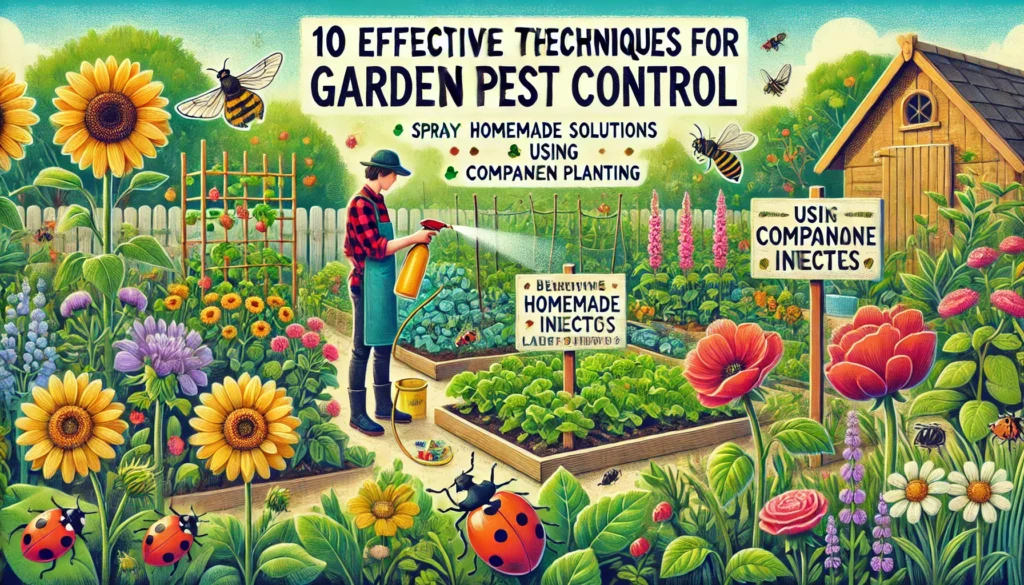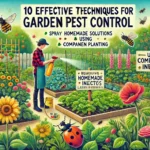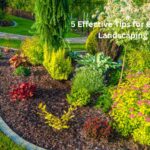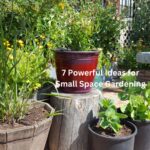Introduction – Effective Techniques for Garden Pest Control
Are pesky insects and critters wreaking havoc on your beloved garden? You’re not alone. Gardeners worldwide face the constant challenge of protecting their plants from unwanted visitors. But before you reach for that bottle of harsh chemicals, consider this: numerous effective, eco-friendly techniques for garden pest control can keep your plants healthy and your conscience clear. This comprehensive guide explores ten game-changing strategies to naturally combat garden pests, ensuring your green oasis remains a thriving sanctuary for beneficial insects and wildlife.
Companion Planting: Nature’s Defense System
Harness the power of companion planting to repel pests naturally. Certain plants act as natural deterrents, protecting their neighbors from harmful insects. For instance, marigolds are known to repel nematodes, while basil keeps mosquitoes and flies at bay. By strategically placing these protective plants throughout your garden, you create a natural barrier against unwanted visitors.
Introduce Beneficial Insects: Your Garden’s Tiny Defenders
Not all insects are harmful to your garden. Some can be your greatest allies in pest control. Ladybugs, praying mantises, and lacewings are voracious predators that feed on common garden pests like aphids and caterpillars. Attract these beneficial insects by planting flowers such as daisies, yarrows, and Queen Anne’s lace, which provide them with nectar and pollen.
DIY Natural Sprays: Homemade Solutions for Pest Problems
Create your own eco-friendly pest control sprays using common household ingredients. A simple mixture of water and mild dish soap can effectively combat soft-bodied insects like aphids and mealybugs. For a more potent solution, try blending garlic, onion, and hot peppers with water to create a natural repellent spray that deters a wide range of pests.
Physical Barriers: Keeping Pests at Bay
Sometimes, the simplest solutions are the most effective. Install physical barriers like row covers, netting, or chicken wire to protect your plants from larger pests such as birds, rabbits, and deer. For slugs and snails, create a protective ring around plants using materials like copper tape or diatomaceous earth.
Crop Rotation: Outsmarting Persistent Pests
Many pests overwinter in the soil, waiting to attack the same crops year after year. By practicing crop rotation, you disrupt their life cycles and reduce the likelihood of recurring infestations. Aim to rotate your crops every season, ensuring that plants from the same family aren’t grown in the same location for at least three years.
Encourage Biodiversity: A Balanced Ecosystem
A diverse garden is a resilient garden. By cultivating a wide variety of plants, you create a balanced ecosystem that naturally keeps pest populations in check. Include flowering plants, herbs, and native species to attract a range of beneficial insects and birds that will help control pest populations.
Handpicking: The Personal Touch in Pest Control
Nothing beats the effectiveness of handpicking for larger pests like caterpillars and beetles. While it may seem time-consuming, this method allows you to closely monitor your plants and catch infestations early. Make it a habit to inspect your garden regularly, removing pests by hand and disposing of them in soapy water.
Organic Mulch: A Multifaceted Approach to Pest Management
Applying organic mulch around your plants offers multiple benefits for pest control. It helps retain soil moisture, suppress weed growth, and provides a habitat for beneficial insects like ground beetles. Additionally, certain types of mulch, such as cedar chips, naturally repel pests like ants and termites.
Neem Oil: Nature’s Powerful Pesticide
Derived from the neem tree, this organic compound is a potent weapon against a wide range of garden pests. Neem oil disrupts the life cycles of insects, preventing them from feeding and reproducing. It’s particularly effective against aphids, mealybugs, and whiteflies. Always dilute neem oil according to package instructions before application.
Trap Crops: Luring Pests Away from Your Prized Plants
Employ the strategy of trap cropping by planting sacrificial plants that attract pests away from your main crops. For example, plant nasturtiums near your vegetables to draw aphids away, or use radishes to lure flea beetles from your main crop. Once the trap crops are infested, remove and dispose of them to eliminate the pests.
Conclusion – Effective Techniques for Garden Pest Control
Embracing natural pest control methods not only protects your garden but also contributes to a healthier environment. By implementing these ten effective techniques for garden pest control, you’ll create a balanced ecosystem that naturally keeps pest populations in check while promoting the growth of beneficial insects and wildlife. Remember, a healthy garden is a resilient garden. With patience and persistence, you’ll soon witness the transformative power of these eco-friendly pest control strategies, enjoying a bountiful harvest and a thriving garden sanctuary.
#GardenPestControl #OrganicGardening #NaturalPesticides #CompanionPlanting #BeneficialInsects #EcoFriendlyGardening #DIYPestControl #SustainableGardening #PestManagement #HealthyGarden
#NaturalWaysToControlGardenPests #OrganicPestControlForVegetableGardens #HowToGetRidOfGardenPestsNaturally #EnvironmentallyFriendlyPestControl #ChemicalFreePestManagementTechniques
The article “10 Effective Techniques for Garden Pest Control” is written by Farhanul Haque, HomeGardenIdeas.com. Our team of passionate writers and experts shares tips and inspiration on gardening, home improvement, and design to help you create your dream space.







